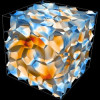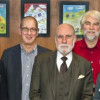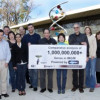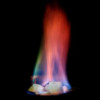News
New Mathematical Method Reveals Where Genes Switch On or Off
Developmental biologists at Stanford University, using computing resources at the U.S. Department of Energy’s National Energy Research Scientific Computing Center (NERSC), have taken a new mathematical method used in signal processing and applied it to biochemistry, using it to reveal the atomic-level details of protein–DNA interactions with unprecedented accuracy. They hope this method, called “compressed sensing,” will speed up research into where genes are turned on and off, and they expect it to have applications in many other scientific domains as well. Read More »
Berkeley Lab Mathematicians Win Cozzarelli Prize
James Sethian and Robert Saye, mathematicians who both hold joint appointments with the Lawrence Berkeley National Laboratory (Berkeley Lab) and the University of California (UC) Berkeley, have won the 2011 Cozzarelli Prize for the best scientific paper in the category of Engineering and Applied Sciences. Read More »
Kathy Yelick Invited Speaker at NITRD's 20th Anniversary Symposium
Kathy Yelick, Berkeley Lab's Associate Laboratory Director for Computing Sciences, is one of 16 speakers invited to share their expertise at a Feb. 16 symposium marking the 20th anniversary of the Federal Networking and Information Technology Research and Development (NITRD) Program. Yelick will give a presentation on "More and Moore: Growing Computing Performance for Scientific Discovery." Read More »
ESnet Policy Board Holds Inaugural Meeting at Berkeley Lab
This month the ESnet Policy Board held its first annual meeting at the Lawrence Berkeley National Laboratory (Berkeley Lab). The seven-member board was created last summer to provide scientific and executive-level advice to the Laboratory’s Director regarding the overall ESnet program. The Policy Board focuses on specific issues such as resource utilization to maximize the present and future scientific impact of ESnet and long-range planning for the program, including research and development necessary for future capabilities. Read More »
Breaking Ground on the Computational Research and Theory Facility
Department of Energy Secretary Steven Chu, along with Lawrence Berkeley National Laboratory (Berkeley Lab) and University of California leaders, broke ground on the Lab’s Computational Research and Theory (CRT) facility, Wednesday, Feb. 1. The CRT will be at the forefront of high-performance supercomputing research and be DOE’s most efficient facility of its kind. Read More »
ESnet Staff Share Expertise, 100G Experiences at Joint Techs Meeting
Twice a year, staff from ESnet and Internet, two of the leading research and education networks, meet to exchange information and experiences on topics of mutual interest. The meetings, known at the Joint Techs, also draw an international crowd of networking experts. Read More »
Can Cloud Computing Address the Scientific Computing Requirements for DOE Researchers?
After a two-year study of the feasibility of cloud computing systems for meeting the ever-increasing computational needs of scientists, Department of Energy researchers have issued a report stating that the cloud computing model is useful, but should not replace the centralized supercomputing centers operated by DOE national laboratories. Read More »
Powered by NERSC, a Database of Billions of Genes and Counting!
Microbes are microscopic organisms that live in every nook and cranny of our planet. Without them, plants wouldn’t grow, garbage wouldn’t decay, humans wouldn’t digest food, and there would literally be no life on Earth, or at least as we know it. By examining the genetic makeup of these “bugs,” scientists hope to understand how they work, and how they can be used to solve a variety of important problems like identifying new sources of clean energy. Read More »
The Great Gas Hydrate Escape
For some time, researchers have explored flammable ice for low-carbon or alternative fuel or as a place to store carbon dioxide. Now, a computer analysis of the ice and gas compound, known as a gas hydrate, reveals key details of its structure. The results show that hydrates can hold hydrogen at an optimal capacity of 5 weight-percent, a value that meets the goal of a Department of Energy standard and makes gas hydrates practical and affordable. Read More »
Bubbles Help Break Energy Storage Record for Lithium Air-Batteries
One of the biggest weaknesses of today’s electric vehicles (EV) is battery life—most cars can only go about 100-200 miles between charges. But researchers hope that a new type of battery, called the lithium-air battery, will one day lead to a cost-effective, long-range EV that could travel up to 300 miles or more between charges. Read More »







 Instagram
Instagram YouTube
YouTube







